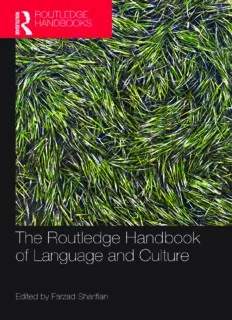
The Routledge Handbook of Language and Culture PDF
Preview The Routledge Handbook of Language and Culture
THE ROUTLEDGE HANDBOOK OF LANGUAGE AND CULTURE TheRoutledgeHandbookofLanguageandCulturepresentsthefirstcomprehensive survey of research ontherelationshipbetweenlanguageandculture.Itprovidesreaderswithaclearandaccessible introduction to both interdisciplinary and multidisciplinary studies of language and culture, and addresses key issues of language and culturally based linguistic research from a variety of perspectives and theoretical frameworks. This Handbook features thirty-three newly commissioned chapters which: (cid:1) cover key areas such as cognitive psychology, cognitive linguistics, cognitive anthropology, linguistic anthropology, cultural anthropology, and sociolinguistics (cid:1) offerinsightsintothehistoricaldevelopment,contemporarytheory,research,andpracticeof each topic, and explore the potential future directions of the field (cid:1) show readers how language and culture research can be of practical benefit to applied areas of research and practice, such as intercultural communication and second language teaching and learning. Written by a group of prominent scholars from around the globe, The Routledge Handbook of Language and Culture provides a vital resource for scholars and students working in this area. Farzad Sharifian is a Professor within the School of Languages, Literatures, Cultures, and Linguistics, and the Director of Language and Society Centre at Monash University, Australia. Routledge Handbooks in Linguistics Routledge Handbooks in Linguistics provide overviews of a whole subject area or sub-discipline in linguistics, and survey the state of the discipline, including emerging and cutting-edge areas. Edited by leading scholars, these volumes include contributions from key academics from around the world and are essential reading for both advanced undergraduate and postgraduate students. The Routledge Handbook of Syntax Edited by Andrew Carnie, Yosuke Sato and Daniel Siddiqi The Routledge Handbook of Historical Linguistics Edited by Claire Bowern and Bethwyn Evans The Routledge Handbook of Semantics Edited by Nick Riemer The Routledge Handbook of Linguistics Edited by Keith Allan THE ROUTLEDGE HANDBOOK OF LANGUAGE AND CULTURE Edited by fi Farzad Shari an Firstpublished2015 byRoutledge 2ParkSquare,MiltonPark,Abingdon,OxonOX144RN andbyRoutledge 711ThirdAvenue,NewYork,NY10017 RoutledgeisanimprintoftheTaylor&FrancisGroup,aninformabusiness ©2015Selectionandeditorialmatter,FarzadSharifian;individualchapters,thecontributors Therightoftheeditortobeidentifiedastheauthoroftheeditorialmaterial,andofthe authorsfortheirindividualchapters,hasbeenassertedinaccordancewithsections77and78of theCopyright,DesignsandPatentsAct1988. Allrightsreserved.Nopartofthisbookmaybereprintedorreproducedorutilisedinany formorbyanyelectronic,mechanical,orothermeans,nowknownorhereafter invented,includingphotocopyingandrecording,orinanyinformationstorageorretrieval system,withoutpermissioninwritingfromthepublishers. Trademarknotice:Productorcorporatenamesmaybetrademarksorregisteredtrademarks,and areusedonlyforidentificationandexplanationwithoutintenttoinfringe. BritishLibraryCataloguing-in-PublicationData AcataloguerecordforthisbookisavailablefromtheBritishLibrary LibraryofCongressCataloginginPublicationData TheRoutledgeHandbookoflanguageandculture/editedbyFarzadSharifian. 1.Languageandculture--Handbooks,manuals,etc.2.Linguistics--Handbooks,manuals,etc. I.Sharifian,Farzad,editor. P35.R682014 306.44--dc23 2014016038 ISBN:978-0-415-52701-9(hbk) ISBN:978-1-315-79399-3(ebk) TypesetinBembo byTaylorandFrancisBooks CONTENTS List of figures and tables ix List of contributors x Acknowledgements xv PARTI Overview and historical background 1 1 Language and culture: overview 3 Farzad Sharifian 2 Linguistic relativity: precursors and transformations 18 John Leavitt PARTII Ethnolinguistics 31 3 Ethnosyntax 33 Anna Gladkova 4 Ethnosemantics 51 John Leavitt 5 Ethnopragmatics 66 Cliff Goddard, with Zhengdao Ye v Contents PARTIII Studies of language and culture 85 6 Linguaculture: the language–culture nexus in transnational perspective 87 Karen Risager 7 Language, gender, and culture 100 Lidia Tanaka 8 Language, culture, and context 113 Istvan Kecskes 9 Language, culture, and politeness 129 Sara Mills 10 Language, culture, and interaction 141 Peter Eglin 11 Culture and kinship language 154 David B. Kronenfeld 12 Cultural semiotics 170 Peeter Torop 13 Culture and translation 181 Nigel Armstrong 14 Language, culture, and identity 196 Sandra R. Schecter 15 Language and culture history: the contribution of linguistic prehistory 209 Patrick McConvell PARTIV Language, culture, and cognition 225 16 Embodiment, culture, and language 227 Ning Yu 17 Culture and language processing 240 Crystal J. Robinson and Jeanette Altarriba vi Contents 18 Language, culture, and prototypicality 253 Frank Polzenhagen and Xiaoyan Xia 19 Colour language, thought, and culture 270 Don Dedrick 20 Language, culture, and spatial cognition 294 Penelope Brown 21 Space, time, and space–time: metaphors, maps, and fusions 309 Chris Sinha and Enrique Bernárdez 22 Culture and language development 325 Laura Sterponi and Paul F. Lai 23 Language and cultural scripts 339 Anna Wierzbicka 24 Culture and emotional language 357 Jean-Marc Dewaele PARTV Research on language and culture in related disciplines/sub-disciplines 371 25 Language and culture in sociolinguistics 373 Meredith Marra 26 Language and culture in cognitive anthropology 386 Claudia Strauss PARTVI Language and culture in applied domains 401 27 Language and culture in second language learning 403 Claire Kramsch 28 Writing across cultures: ‘culture’ in second language writing studies 417 Dwight Atkinson 29 Language and culture in second dialect learning 431 Ian G. Malcolm vii Contents 30 Language and culture in intercultural communication 445 Hans-Georg Wolf 31 World Englishes and local cultures 460 Andy Kirkpatrick PARTVII Cultural linguistics: past, present, and future directions 471 32 Cultural Linguistics 473 Farzad Sharifian 33 A future agenda for research on language and culture 493 Roslyn M. Frank Index 513 viii FIGURES AND TABLES Figures 4.1 Pronominal dimensions 60 8.1 Understanding context 118 8.2 The dynamic model of meaning 120 12.1 Jakobson’s model of communication 171 12.2 Hierarchy of objective and descriptive languages 174 12.3 Metacommunication and intercommunication 177 16.1 The difference between Western and Chinese cultures in the conceptualization of ‘person’ 234 21.1 An Amondawa speaker spatially maps the seasonal time intervals 318 30.1 The artefactual result of a conceptual blend, with Western eating utensils and Asian eating utensils as separate input spaces 456 32.1 A diagrammatic representation of Palmer’s (1996) proposal for Cultural Linguistics 474 32.2 Model of cultural cognition, cultural conceptualizations, and language 478 32.3 Diagrammaticrepresentationofaculturalschema(adaptedfromSharifian,2011) 479 Tables 1.1 Three different paradigms in the history of the study of language as culture (Duranti, 2003) 4 5.1 Semantic primes (English exponents) 67 5.2 Fifty Anglo English cultural keywords (Wierzbicka 2014) 70 15.1 The terms mana, marna and japi in Walmajarri and Warlpiri 219 17.1 Summary of relevant findings 250 21.1 Space–time correspondences in the genetically unrelated Andean languages Aymara (Nuñez and Cornejo 2012) and Quechua (e.g. Hurtado de Mendoza 2002; Bernárdez, 2014) 320 32.1 A comparison of Aboriginal and Anglo-Australian meanings for ‘family’ 484 33.1 Traditional view and distributed cognition view (adapted from Waloszek (2003); Hollan, Hutchins and Kirsh (2000)) 502 ix
Description: